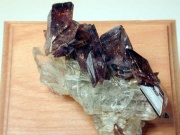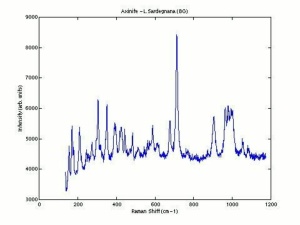Axinite
Jump to navigation
Jump to search
Description
A rare, transparent to translucent clove-brown (root beer) gemstone with flashes of violet and gray. Axinite was first discovered in Bourg d'Oisans in France. Current sources include alluvial deposits in Sri Lanka and some mines in the U.S.(California, Nevada, New Jersey). Axinite crystals may also be colorless, yellow, or black. The crystals are pyroelectric and piezoelectric.
Synonyms and Related Terms
Axinit (Deut.); axinita (Esp.)
Risks
- Axinite is piezoelectric (develops a charge when heated) and may attract dust when displayed under a hot light.
Physical and Chemical Properties
- Triclinic crystal system often found as flattened tabular crystals with sharp edges and striations
- Cleavage good in one direction
- Fracture = uneven to conchoidal
- Luster = greasy to vitreous
- Streak = colorless
- Fluorescence = generally inert; yellow stones may fluoresce red in SW
- Pleochroism = strong: violet to purple, light yellow, and red-brown
| Composition | (Ca,Mn,Fe,Mg)3Al2BSi4O15(OH) |
|---|---|
| Mohs Hardness | 6.0 - 7.5 |
| Density | 3.18 - 3.37 g/ml |
| Refractive Index | 1.67 - 1.72 |
| Birefringence | 0.010 - 0.012 |
Resources and Citations
- Gem Identification Lab Manual, Gemological Institute of America, 2016.
- R.F.Symmes, T.T.Harding, Paul Taylor, Rocks, Fossils and Gems, DK Publishing, Inc., New York City, 1997
- C.W.Chesterman, K.E.Lowe, Audubon Society Field Guide to North American Rocks and Minerals, Alfred A. Knopf, New York, 1979
- Encyclopedia Britannica, http://www.britannica.com Comment: "axinite." Accessed 3 Sept. 2005 : hardness = 6.5-7.5, RI=1.67-1.70, sp=3.3-3.4
- Wikipedia: Axinite (Accessed Sept 2, 2005 and Dec 2022), hardness = 6.0-7.5, RI=1.68-1.723, sp=3.18-3.37



